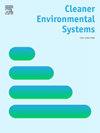Simulation and techno-economic evaluation of integrated palm oil mill processes for advancing a circular economy
IF 4.9
Q2 ENGINEERING, ENVIRONMENTAL
引用次数: 0
Abstract
The palm oil industry faces increasing pressure to adopt sustainable and circular production practices, particularly in waste management and greenhouse gas (GHG) emissions reduction. Integrated biomass utilization within palm oil mills (POMs) offers a promising approach to improve both environmental and economic outcomes. This study evaluates the techno-economic and environmental performance of an integrated POM system incorporating palm oil mill effluent (POME) treatment, empty fruit bunch (EFB) composting, and residual oil recovery within a unified flowsheet. A detailed simulation model of a 60 MT/h mill was developed using SuperPro Designer® software, based on actual mill operations and literature data. The model assessed mass and energy balances, capital and operating costs, and carbon dioxide (CO2) equivalent emissions. Results showed a 5 % increase in revenue through by-product valorization and a 53 % reduction in CO2 equivalent emissions when combining EFB composting with biogas capture. The system achieved a positive net present value (NPV) of MYR 75.63 million, an internal rate of return (IRR) of 30.08 %, a return on investment (ROI) of 19.20 %, and a payback period (PBP) of 5.21 years. Sensitivity analysis showed that the prices of fresh fruit bunches (FFB), crude palm oil (CPO), and the CPO yield are key factors influencing economic performance. These outcomes highlight the feasibility of implementing circular economy principles, where waste streams are transformed into valuable products such as compost, biogas, and recovered oil, thereby closing material loops and reducing environmental impact.
推进循环经济的棕榈油综合加工工艺模拟与技术经济评价
棕榈油行业面临越来越大的压力,需要采用可持续和循环生产实践,特别是在废物管理和温室气体(GHG)减排方面。棕榈油厂(POMs)的综合生物质利用为改善环境和经济结果提供了一种有希望的方法。本研究评估了综合POM系统的技术经济和环境性能,该系统包括棕榈油厂废水(POME)处理、空果束(EFB)堆肥和在统一流程内的剩余油回收。基于实际磨机操作和文献数据,使用SuperPro Designer®软件开发了60 MT/h磨机的详细仿真模型。该模型评估了质量和能量平衡、资本和运营成本以及二氧化碳当量排放。结果表明,当将EFB堆肥与沼气捕获相结合时,通过副产品增值,收入增加了5%,二氧化碳当量排放量减少了53%。该系统的净现值(NPV)为7563万令吉,内部收益率(IRR)为30.08%,投资回报率(ROI)为19.20%,投资回收期(PBP)为5.21年。敏感性分析表明,鲜果串(FFB)价格、粗棕榈油(CPO)价格和粗棕榈油产量是影响经济效益的关键因素。这些成果突出了实施循环经济原则的可行性,在循环经济原则中,废物流被转化为有价值的产品,如堆肥、沼气和回收油,从而闭合物质循环,减少对环境的影响。
本文章由计算机程序翻译,如有差异,请以英文原文为准。
求助全文
约1分钟内获得全文
求助全文
来源期刊

Cleaner Environmental Systems
Environmental Science-Environmental Science (miscellaneous)
CiteScore
7.80
自引率
0.00%
发文量
32
审稿时长
52 days
 求助内容:
求助内容: 应助结果提醒方式:
应助结果提醒方式:


